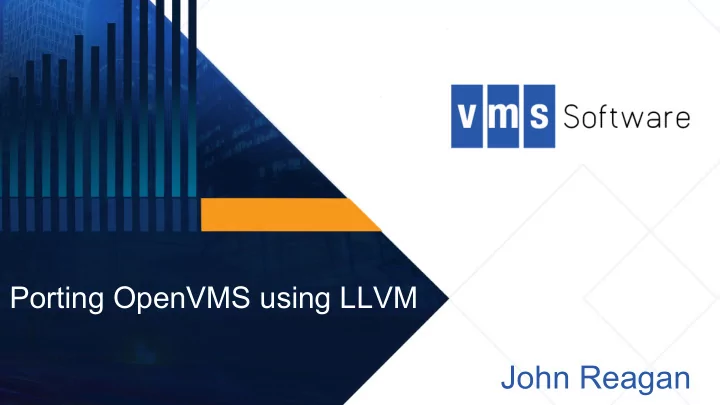

Porting OpenVMS using LLVM John Reagan 1
VAX/VMS • Digital introduced the VAX-11, a 32-bit CISC architecture, 40 years ago in 1977 (before most of you were born) • Modeled after the PDP-11 with 16 general purpose registers used for integer and floating • While Berkeley and Bill Joy did 3BSD and beyond, Digital’s OS “VAX/VMS” was the main operating system for VAX • Many compilers on VAX/VMS (Ada, BASIC, BLISS, C, C++, COBOL, Fortran, Pascal) with assorted code-generators • OS was written in VAX assembly (called Macro-32) and VAX BLISS 2
OpenVMS Alpha and Itanium • In 1992, Digital introduced Alpha, a 64-bit RISC architecture • New single common code generator named GEM with a target independent IR and symbol table • New Macro-32 Alpha compiler to allow OS to use existing VAX “assembly” • In 1998/2002, Compaq bought DEC, HP bought Compaq, killing Alpha • New GEM target for Itanium; switched to ELF/DWARF; switched C++ compilers to Intel/EDG-based compiler; another Macro-32 compiler • Most Itanium compilers (BASIC, BLISS, C, COBOL, Fortran, Pascal) still use the common GEM backend • OS now a mixture of BLISS, C, and Macro-32 3
OpenVMS Itanium Compilers BASIC BLISS C COBOL GEM GEM IR .OBJ .OLB LINKER .EXE LIBRARIAN Fortran PASCAL IMACRO C++ Intel
OpenVMS x86-64 • HP licensed OpenVMS to VMS Software Inc in 2014 for future platform support which includes porting to x86-64 • GEM is stale and doesn’t know x86-64 • Instead of throwing money at GEM, we picked LLVM to get modern code base and not have to chase all possible chip features • Still need to provide “recompile and go” for customers • Leverage existing frontends which generate GEM IR/symtab • Create a GEM IR to LLVM IR converter (G2L) • Leverage clang as our C++ offering 5
OpenVMS x86-64 Compilers BASIC BLISS Internal Representation Backend Code Generator Converter C COBOL G2L LLVM LLVM IR LIBRARIAN GEM IR .OBJ* Standard Standard Fortran SS Interface Interface MCInst Standard Interface .OLB Interface PASCAL XMACRO LINKER .EXE* C++ clang * = ELF like Itanium
GEM Meets LLVM • Map GEM IR nodes (~275) to LLVM IR nodes • About 240 GEM IR nodes have been mapped sufficient for BLISS and C • Remainder used by other frontends and will get mapped as needed • GEM has a richer set of primary datatypes so support for things like COBOL packed decimal arithmetic not yet implemented • Many GEM nodes have nice simple mappings, but some result in interesting IR sequences or clever converter abstractions (strings for example) • Converter currently about 15K lines of C++ (source & headers & comments) • Debug info, long double, VAX floating support is TBD 7
ABI and OpenVMS-isms • Will use the industry standard AMD64 ABI with a few upward compatible extensions for things like argument count and to assist in performing VMS-style argument list homing • Will use libc++ and some of libc++ ABI • Continue to use OpenVMS’ debugger and linker • Continue to use parts of GEM for command line, source file management, etc 8
LLVM Meets OpenVMS • A handful of OpenVMS additions to LLVM • Mixed pointer size linker relocations • Complex LTCE linker relocations • “.note” section generation for module name, compilation date/time, etc • ABI additions for argument count and arg-info in RAX register • Additional DWARF language tags • Additional EH unwind descriptors for Macro-32 VAX register emulation • Hooks for machine code listings 9
Clang Meets OpenVMS • Attempt to be compatible with the C++ compiler on OpenVMS Itanium • Need to add/modify some behaviors like dual-sized pointers; interface with GEM for command line processing, include file processing, error message generation, listing file generation, etc • Only in initial investigation stage 10
Challenges • Itanium C++ compiler is only C++03 so we’re using LLVM 3.4.2 and will have to bootstrap to newer LLVM once on native system with clang in place • The OpenVMS versions of bash, make, etc are mostly ok for the job but will have to port CMake eventually • Headers and CRTL needs to become compatible with both clang and our traditional C compiler • OpenVMS doesn’t have “compiler drivers” in the traditional UNIX sense • Variable length argument list in AMD ABI doesn’t mesh well with OpenVMS style which might force some source code changes for customers 11
Current Status • Cross C and BLISS compilers are effectively 99% complete with just a few issues with variable length argument lists to iron out • The cross Macro-32 compiler is a little farther behind. The compiler was designed around mapping VAX CISC instructions to Alpha and Itanium RISC style machines. Getting reasonable x86-64 code has resulted in some deeper changes especially with emulating VAX condition codes • The OS can currently boot into the initial kernel level debugger with many other components are building and linking • Our current schedule for OS boot to the shell and issue a directory command is for Q1CY18 12
Recommend
More recommend